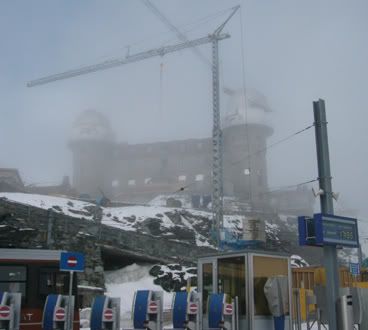Hauer Observatory
Hauer Observatory, located on the Gomsgrat in the Thuvian Mountains in Nolanstadt, Mikitivity, was built in 1936 as a joint project between the Mikitivity Government and Miervatia University. Proposed by Wolf Hauer as an isolated observatory that would house one of the largest optical telescopes of its time far away from any light pollution. The observatory was originally designed with a sizable dormitory, complete with class room space. Gomsgrat was choosen in part for the high elevation of its summit, and part because it was far enough away from Miervatia City that there is a greater chance that either the view from Hauer Observatory or Miervatia University Observatory would not be obscured by low cloud cover.
Originally the observatory was named the Nolanstadt Observatory, but following Hauer's death in 1953, Miervatia University petitioned the people of Nolanstadt to agree to renaming the observatory in honor of Wolf Hauer. Three years later, the observatory was renamed after recieving over 90% of the votes in a referendum on the issue.
The main telescope at the observatory is the 200 inch primary focus Schweickart Telescope. The Schweickart Telescope replaced the original 48 inch reflector Cernan Telescope that was built along with the rest of the observeratory in 1936. Though astronomers can still climb in the Schweickart Telescope for direct observations, most research for both telescopes is conducted via cameras.
Today both telescopes are in constant use and the observatory is open for visitors year round. Following the passage of the Tracking Near Earth Objects United Nations resolution in 2004, Mikitivity's Council of Mayors implemented a Near Earth Objects Tracking program, which is headquartered out of the Hauer Observatory. Tracking data from the Hauer telescopes is collected and distributed upon request to any government interested in potential near earth objects. The original dormitory and class rooms built for the university have been upgraded several times and now include permanent offices for the government staff in charge of the tracking program. Foreign astronomers are welcomed to the facility year-round and are invited to stay for free as guests for extended durations.
Access to the observatory is limited to cog rail only. The train leading up to the observatory also serves as only transportation to several ski runs (in winter) and hiking trails (in late summer) along the Gomsgrat. The company that operates the train, GomsBahn, is not directly affilated with Mikitivity Bahn and charges passengers. However, the observatory reimburses visitors and employees for their full costs of traveling up to the observatory. As such, it is common for skiers to actually dine outside the observatory in order to get their train fare validated, and then ride the train back to one of the ski runs further down from the mountain summit. This practice is allowed to continue, as it has brought in a steady revenue to the observatory.

